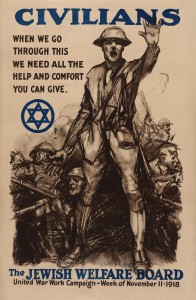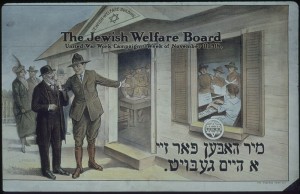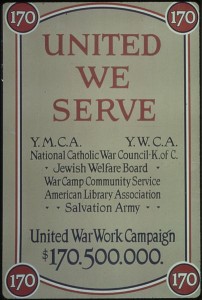
A History of the Jewish Welfare Board
The Jewish Welfare Board was formed by a group of prominent Jewish Americans on April 9, 1917, as a response by the American Jewish Community to the United States’ entry into the First World War on April 6th. Although Jewish Americans represented a large and diverse community, they had no single organization that was positioned to execute war work on behalf of Jews at the beginning of the war. For this reason, members of more than ten national Jewish groups met and agreed that each of their groups would delegate power to a new agency, the Jewish Welfare Board.[1]
While the American Jewish community had formed a single group dedicated to providing war work services to American soldiers, they were not immediately incorporated into the United States war work effort as run by the Commission on Training Camp Activities. The War Department had previously established the Commission, whose duty was to defend and protect the moral well being of the American soldier. The Commission on Training Camp Activities almost immediately partnered with the Young Men’s Christian Association (YMCA), but refused to allow other religious groups, including Catholics, to become partner agencies. The chairman of the Commission on Training Camp Activities, Raymond Fosdick, eventually “agreed to give the Welfare Board informal authorization to serve as one of the government’s agents for welfare work with soldiers.”[2] By September of 1917, the Jewish Welfare Board was the official Jewish partner of the Commision on Training Camp Activities, one of five American religious groups chosen for partnership.

During the war, the Welfare Board organized an incredible number and variety of war work components in U.S. armed forces camps at home and overseas. The Board provided spiritual support to 225,000 Jewish soldiers, while also serving the interests of the American armed forces at large.[3] According to the executive director of the Jewish Welfare Board, Chester Jacob Teller, one contribution was the erection of “thirty buildings, not to overlap, not to duplicate, but to supplement the facilities created by other agencies,” to be used for recreational and religious purposes.[4] Their goal was not to compete with other participating agencies, but to succeed together. Additionally, the Jewish Welfare Board secured “governmental sanction… for the sale of Kosher non-perishable food products in the camps” where Jewish soldiers were stationed.[5] In this action, the Jewish Welfare Board hoped to give each soldier the ability to pursue his religious traditions during wartime. Whether they were Jewish or not, the Board provided moral guidance, religious services, and virtuous recreation to as many soldiers as possible over the course of the conflict in order to support American boys in their time of need.
Americanization and Acceptance

While the Jewish Welfare Board was created for the purpose of supporting American soldiers during the war, it was also focused on fostering acceptance of the Jewish community by the American public. Facing a predominantly Protestant society in the early twentieth century, the Jewish Welfare Board clashed with an “invisible sectarianism” that colored the beginnings of the United War Work Campaign.[6] While the YMCA was immediately chosen by Chairman Fosdick to partner with the Commission on Training Camp Activities, he and Secretary of War Newton Baker believed that it would act without religious bias, serving American soldiers regardless of their religious affiliations. Only the exclusion of Catholic and Jewish representatives on the YMCA’s National War Work Council forced a reluctant Fosdick to acknowledge the implicit sectarian divisions between the groups of the United War Work Campaign operating under the Commission on Training Camp Activities.[7]
The challenges that the Jewish Welfare Board faced in its struggle for official government recognition were indicative of the larger question of the Jewish role in American society. Members of the Jewish Welfare Board and of the Jewish community as a whole were eager to show that the beliefs of Judaism do not conflict, but instead intertwine, with the aspirations of American democracy. An article in the American Israelite states that the goal of the Board was “to help Jewish boys to adjust themselves to understand and sympathize with their gentile brothers-in-arms and to be in turn understood by them.”[8] The Jewish Welfare Board went to great lengths to facilitate unity within the groups of the United War Work Campaign, in order to emphasize its harmony with the American ideals of the day. After its recognition as a formal partner of the Commission on Training Camp Activities, the Jewish Welfare Board showed a remarkable amount of cooperation with other member groups. The YMCA, which had originally denied the Board a position on its National War Work Council, had built a friendly relationship with the Jewish Welfare Board by the end of the war. Dr. John Mott, a leader of the YMCA, said that the work of the Board was of “distinctive and vital function,” and “cannot be done by any other organization of workers.”[9] Father John Burke, chairman of the National Catholic War Council, corresponded regularly with Chairman Harry Cutler of the Jewish Welfare Board, and they agreed on the importance of a unified fundraising drive as part of the United War Work Campaign.
Once incorporated into the “Seven Sisters” of the United War Work Campaign, the Jewish Welfare Board was able to both support American soldiers and sailors as well as demonstrate the indivisibility of the Jewish and American spirits.
Colonel Harry Cutler
Harry Cutler served as the chairman of the Jewish Welfare Board during the Great War, acting on behalf of his fellow Jewish Americans. Cutler was born in Russia in 1876. He came to the United States eight years later with his mother and sister after a escaping a pogrom that counted Cutler’s father as one of its victims.[10] By the early 1900s, he had become a successful jewelry manufacturer who was quickly gaining the respect of Providence, Rhode Island community, even being appointed to the National Board of Trade and elected to the Rhode Island General Assembly.[11]
Likely because of the experiences of his family and his heritage as a Russian Jew, Cutler embraced the causes of Zionism and Jewish relief work around the globe. After the Kishinev pogrom of 1903, he organized and served as chairman on the United Jewish Relief Committee of Providence. As chairman, Cutler was able to unite 44 different Jewish community organizations to work in harmony.[12] Although the Committee did not last, this feat cemented his leadership abilities among American Jews.
Not surprisingly, then, Harry Cutler replaced Cyrus Adler as Chairman of the Jewish Board for Welfare Work in July of 1917.[13] Members of the board believed that Cutler would be more representative of the group (later to be renamed the Jewish Welfare Board) as a Jewish immigrant from Russia, rather than Adler, who came from a German background. Furthermore, Cutler had earned the title of “Colonel” while serving with the Rhode Island National Guard, giving him added credibility with the military. As its new Chairman, Cutler pushed relentlessly on his government to provide for Jewish soldiers serving in the armed forces. After visiting Washington, D.C. in August, 1917, “officials assured Cutler that Jewish servicemen at home and abroad would have adequate facilities for religious services and social events, enough furlough time for the high holy days, and Jewish chaplains in the near future.”[14] His lobbying efforts also resulted in formal recognition for the Jewish Welfare Board, allowing them to act as the official Jewish war work agency throughout the war.[15]
After the conclusion of the First World War, Harry Cutler was elected by the American Jewish Congress to a delegation to represent Jewish interests at the Paris Peace Conference. His goal at the conference was to secure equal rights for Jews around the globe, which was met with mixed success.[16] In 1919, Cutler was awarded the Distinguished Service Cross by Secretary of War Newton D. Baker, and died soon after on August 28, 1920.[17]
[1]Chester Jacob Teller, “The Jewish Welfare Board,” The American Jewish Yearbook 20, (September 1918 – September 1919): 89, accessed June 24, 2015, http://0-www.jstor.org.lib.hope.edu/stable/23600992.
[2]Jessica Cooperman, “The Jewish Welfare Board and Religious Pluralism in the American Military of World War I,” American Jewish History 98, no. 4 (October 2014): 245.
[3]Rufus Learsi and Abraham J. Carp, The Jews in America: A History (New York: KTAV Publishing House, 1972), 250-51.
[4]Teller, “The Jewish Welfare Board,” 91.
[5]Teller, “The Jewish Welfare Board,” 93.
[6]Cooperman, “The Jewish Welfare Board,” 242.
[7]Cooperman, “The Jewish Welfare Board,” 243-44.
[8]“War Chest Uniting People,” American Israelite, November 14, 1918, accessed July 24, 2015.
[9]Dr. John Mott to Jewish Welfare Board, in Manual for Speakers in the United War Work Campaign, (New York: Jewish Welfare Board, 1918), 5.
[10]Stanley B. Abrams, “Harry Cutler: An Outline of a Neglected Patriot,” Rhode Island Jewish Historical Notes 9, no. 2 (November 1984): 128, accessed July 8, 2015, http://www.rijha.org/wp-content/uploads/2013/01/9-2-Nov-84-127-160.pdf
[11]Abrams, “Harry Cutler,” 128.
[12]Abrams, “Harry Cutler,” 129.
[13]Abrams, “Harry Cutler,” 136.
[14]Abrams, “Harry Cutler,” 136.
[15]Abrams, “Harry Cutler,” 136.
[16]Abrams, “Harry Cutler,” 136-37.
[17]Abrams, “Harry Cutler,” 138.